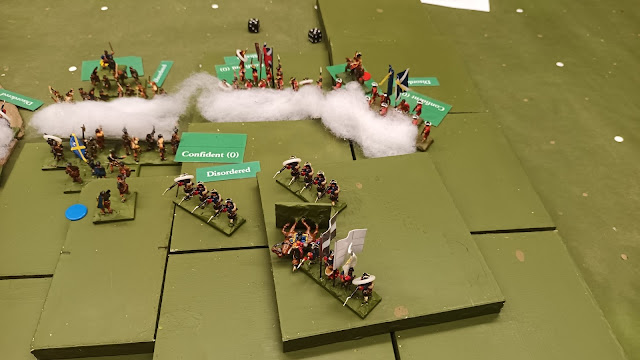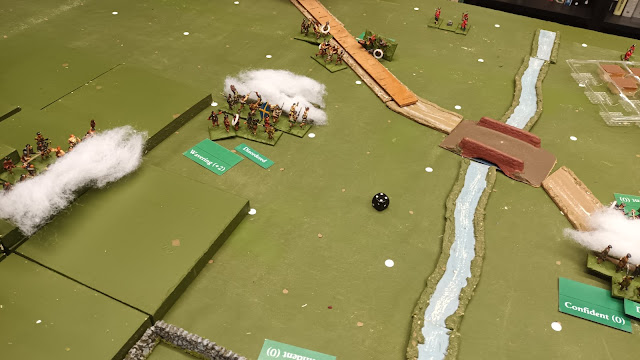After a short hiatus we were back with the Hanoverians and the Jacobites. In my endless quest for inspiration this game was based upon the 1719 invasion and the battle of Glenshiels. This attempt by the Jacobites was backed by the Spanish and like all of them ended in defeat. For the purpose of this game in order to conceal the scenario a bit I called it the Battle of Glen Kerns and set in the post Culloden period. The Jacobites with French regular support are deployed up the glen. The hills are very difficult ground that you can't charge across. The Scots are mostly clans men, with some lowlanders blocking the road. The Loyalist forces have two regular British units, a couple of loyal clans and some Dutch and Hanoverians. They have two Coehorn mortars in support.
We had a bit of confusion over meeting up in the last week or so, and we moved the game to Wednesday evening.
We started with Ian and John on line playing the Jacobites, and Richard in the Shed. The Loyalists have 10 turns to break the Jacobites. If they last that long, then they can escape under cover of night.
Richard decided to shift the line of attack and so started to march his men to his left. He opened up with his mortars, but was unable to find a target.
John reacted by moving his men up into line. The game was designed for fewer players, with one side being mostly on the defensive. As Chris and Phil arrived it might have been that it was a bit small for five players.
Richard's aim was to flank the Jacobite line on their right.
Musketry broke out. The French delivered a lot of damage on the British infantry to their front, with some lucky dice. The difficult terrain makes if harder for the British to close to point blank range. The other two units, being clans men and Dutch opened up and inflicted some hits.
A proper firefight broke out. All a little less frenetic than usual.
I haven't been giving the other flank so much attention, partly because I didn't have my big camera with me. I forgot it, and by the time I remembered it was hammering down outside, so I stuck with the phone and kept dry. Phil had arrived and taken over the Loyalist right wing, so he was pressing hard. Ian had swung his flanking unit round to enfilade Phil's clans men, then closed with his other unit. The clan in the enclosure held their ground and opened fire.
The "Wavering" status continues to be a contra-indicator, and they drove their confident opponents back off the ridge.
They followed up with the bayonet, which broke the French, and the Jacobite general got killed in the melee.
The Hanoverians forced their way into the enclosure.
The Wavering clan followed up their initial success with more of the same, breaking their opponents.
John also counter attacked with the troops on his flank. I'd note at this point that the Coehorns had been firing constantly and inflicted about one hit. Not what was expected.
Ian's Highlanders drove the Hanoverians out of the enclosure. The writing was on the wall for the Loyalists.
And that was it. The Jacobites broke through in the centre, and that was half of the Loyalist Army gone, so they retired from the field. The British battalions were undefeated, but the rest of the army had proved a bit flaky.
A complete reversal of the historic outcome, and it also saw a change in tactics from the Jacobites. Immediate reflections would be that the Coehorns failed miserably. They rolled 36 dice during the game and inflicted two hits, when looking for sixes. Historically their performance surprised the Jacobites considerably, so they were softened up when the Loyalists attacked. Also, in the original battle the clans relied upon musketry, and held firmly to the hillsides. I might need to look at the scenario rules for their shooting to make it less effective. There are still some bits of the rules I need to work on to ensure the balance is right. A while back I altered how the numbers were calculated for firing and I fiddled with the platoon firing mechanism. I don't know that this has improved things very much.
The truth is that I am rowing back on my belief that the Jacobite and Marlburian rules can be combined into one set. It is making things more complicated than I really want them to be, and I'm digging a big hole around differentiating the various troop characteristics.
More to think about.














Comments
Post a Comment